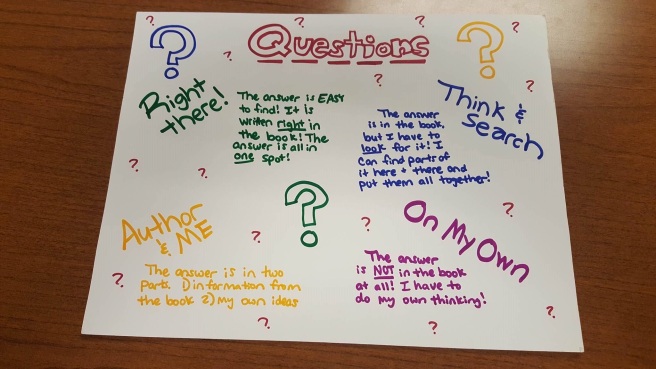QAR is a strategy that has increased in popularity over the years. It is used when you are assessing your student’s reading comprehension. When we read to children, it is crucial that we stop and question frequently to check if they are understanding the book – fully comprehending the text.

The QAR strategy explains to children the different places they can find answers to comprehension questions. These types of question-answer-relationships fall into 4 categories:
- Right There. From my experiences as an educator, students like these the best. Why? Because they are the easiest. Also because when kids answer these, since they found the answer directly in the book, they know they have the right answer before they turn in their paper or before they answer out in class. These are questions that can be answered directly from the book or passage they are reading. Very simplified example: “What color of dress was the main character wearing at the tea party?” This will come directly from the text: “… was wearing a blue dress at the tea party.” The answers to these questions can be something the child remembers directly from the text, or they can merely skim back through the pages to find the answer. These questions do have their place in comprehension. They could be details from the story that are important to the overall understanding of the text, they could direct the student’s attention to a detail that will be important later on, etc.
- Think & Search. These questions require the student to look in several parts of the reading materials to fully get the correct answer. For example, “How is one character different from another character in a given book?” Well, there will be a multitude of examples from the book to pull together to answer this type of a question. The answer can be found in the book though, just not in one nice location as it would be for the ‘right there’ questions.
- Author & Me. The answers to these questions require students to gather information from the book they are reading and information from their own background knowledge and experiences. For example, “How are you similar to the main character of the story?” The child would then think about themselves and the experiences and compare them to information from the story about the main character. This also aids the child in making text-to-self connections which are so important for full comprehension of a story.
- On My Own. Students often get stumped on these types of questions. These are questions which require the student to come up with their own response without gathering any information from what they are reading. Therefore, the answer to these questions are not in the text at all. An example could be, “What would you do if you were in a similar situation as the main character?” The student has to respond with their own ideas of how they would act/respond. There truly is no ‘wrong answer’ here – unless their response is completely off-base. This can stump children because they want to have the ‘right answer,’ but for these types of questions – each individual student will have their own answer different from everyone else’s.
Teachers: Teaching this strategy and displaying it on anchor chart in your classroom will work wonders with your students when they constantly ask, “Where do I find the answer?” You can review over the four types of question-answer-relationships to see how and where they think the answer can be found.
Parents: This strategy hopefully gave you some ideas of how to ask questions to your child when you are reading aloud to them at home. It is always a good thing to stop and question our children while we read to them to see that they are “getting” the information.
Happy Reading!
Dr. Precise
